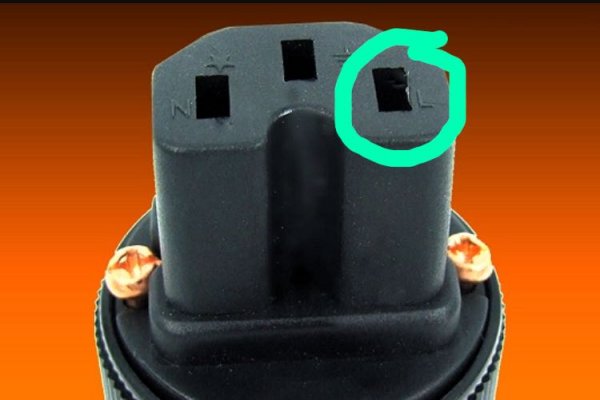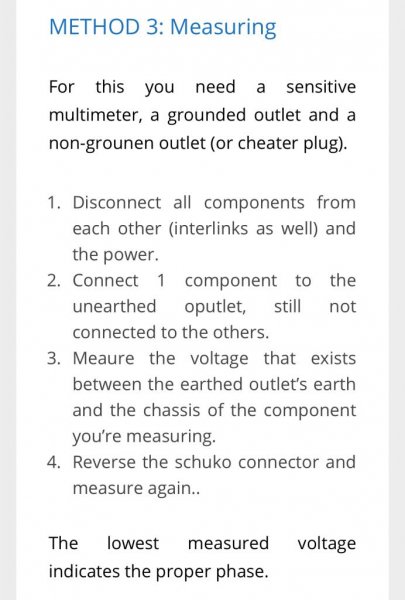Electrical phase...
- Thread starter Stereophonic
- Start date
You are using an out of date browser. It may not display this or other websites correctly.
You should upgrade or use an alternative browser.
You should upgrade or use an alternative browser.
I do not personally know if this is correct, but, in the the USA, audiophile-knowledgeable electricians have always told me to "put all circuits for the stereo system on the same side of positive phase." When I look at an American electrical panel this means that the audio circuits are in every other position in the circuit breaker panel when viewed vertically (meaning, if I look at the left side of the panel then the audio circuits are every other circuit breaker on the left side).
Given the utter non-understanding produced in this thread in only 3 posts... I wonder if this subject is even worth bringing up. I say that because whatever you fellow think you know so far, you need to throw it out with the trash. That isn't being said to bugger you, it is because you're really far off.
I believe you'll find the procedure detailed here, and as always use proper care when taking AC power measurements. Hope this helps!
Thank you very much !!!!
I simply read the OP of this thread and did a search to find related information. I then shared the link provided which is from the website of a well established and highly regarded audio dealer. I apologize to those who find the information on that page to be incorrect or alarming but simply shared what I found trying to be helpful, the phrase 'please don't shoot the messenger' applies here.
Hi Hi-FiGuy.Verifying/measuring your home electrical phase and the phase of your equipment are two VERY different things and are measured separately.
Once you figure that out, there is very little risk of ending your life in finding true phase.
That article is alarming, please don't do that.
The home electrical test phase is very easy. I only have to verify where the current flows ( Line pin ).
This line has to be on the same line output of the iec power cable.
If the electronic has the right design all finish here, but i can’t be sure of that.
Obviously, working with AC is always a risk but with the right information it isn’t too much difficult.
Anyway, your safety recomendation is welcome.
Well over 99.99% of all US homes have single phase power. It's industrial and commercial locations that have three phase power.
The word that you are looking for is polarity. Same thing goes for loudspeaker cable connections.
The word that you are looking for is polarity. Same thing goes for loudspeaker cable connections.
Well over 99.99% of all US homes have single phase power. It's industrial and commercial locations that have three phase power.
The word that you are looking for is polarity. Same thing goes for loudspeaker cable connections.
Hi Speedskater.
I’m from Europe. Schuko plug....
Greetings.
Don't listen to electricians on this stuff. They know how to wire you house, but it is very rare that they actually know a lot about how electricity works or how to describe it.
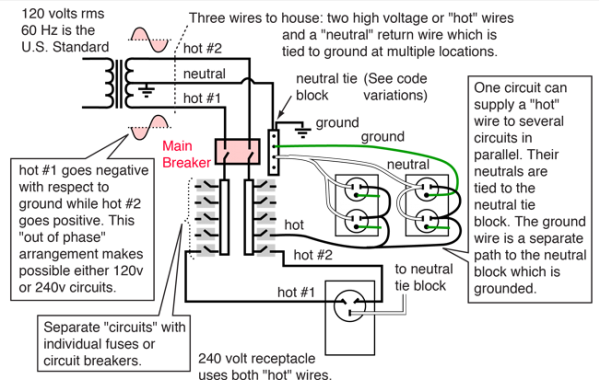
This is how AC systems actually look. Yes, as Speedskater says it is really only a single phase. However the phase gets split (center tap) so that you can have 120v instead of 240v. This gives you two effective poles that are "hot" (Line). These are the alternating spots for breakers that Ron mentioned.
Neither is positive and neither is negative on the poles. As you can see each pole has 360* of phase, and it flips between "negative & positive" every 180* there for there is "phase" because it is alternating (AC) up and down at 60 times a second (60hz). The neutral as you can see by itself cannot complete a circuit by connecting to SG (safety ground, the one connected to ground rod), because the path doesn't cross any of the transformer windings (SG & neutral are connected). But for both Hot poles (Lines), you can see that if they touch the other Hot, or SG it makes a complete circuit that includes the winding of the transformer. In this picture there is a primary and secondary winding, and the CT splits the secondary winding in two.
Here's an example of how Neutral cannot make a path through any windings of the transformer to complete a circuit that has power:
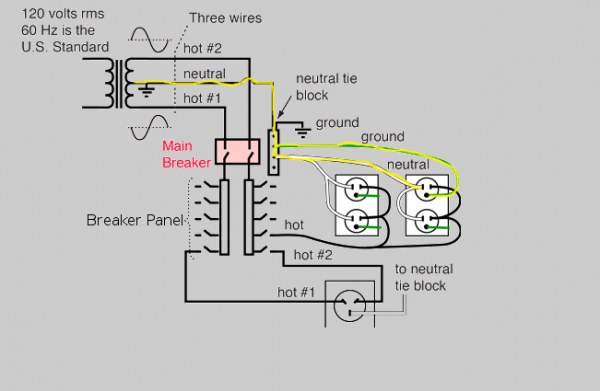
Here's how a normal connection is made for 120v that will complete a circuit through the transformer:
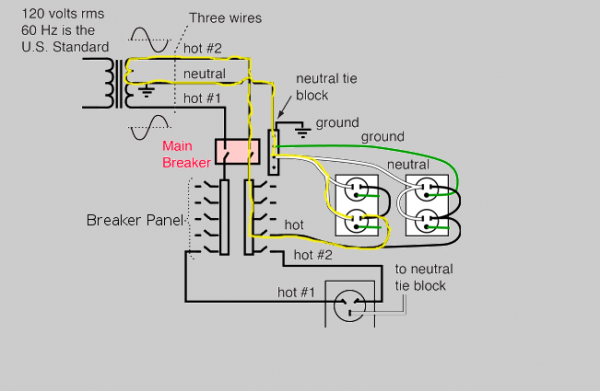
Here's how the two Hot poles can make 240v completing a circuit through the entire phase of the transformer:
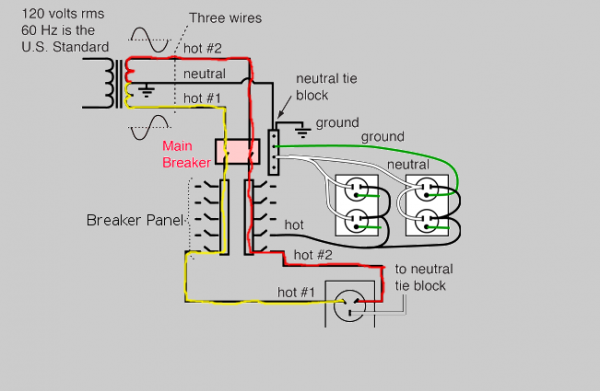
Stereophonic: What your picture shows is just a way to determine which socket hole is Line (Hot). You put one test probe on SG and then see which L or N gives you 120v. The one that does give 120v is Hot, and true Line. If the small blade on the socket, or the L marking on an IEC cord does give you 120v, then you have the polarity swapped at some point (L and N were swapped).
audio.bill: Your link actually has nothing to do with polarity or phase at all of the electrical system, and only to do with polarity of the equipment. What it describes is finding which input wire of your transformer has the least amount of capacitance to the enclosure. Sadly there isn't much you can do about the problem without getting into the amplifier. Yes you can fiddle by swapping wires in the cord, but what you do is change where the fuse is applied, and that is a bad idea. Hopefully the designing should know better... The correct fix is to swap the transformer leads to corresponding switch & fuse, and neutral.
Ron Resnick: Again there is no positive. What your electrician is wanting to say, were he to understand it much better, is that you should only use 1 pole (1 Hot side of the transformer 120v) for the whole stereo. This is a decent idea for a few reason. Here's a drawing where you can see only one pole is used for the sockets. Please note that in a real breaker box the poles are mixed every other.
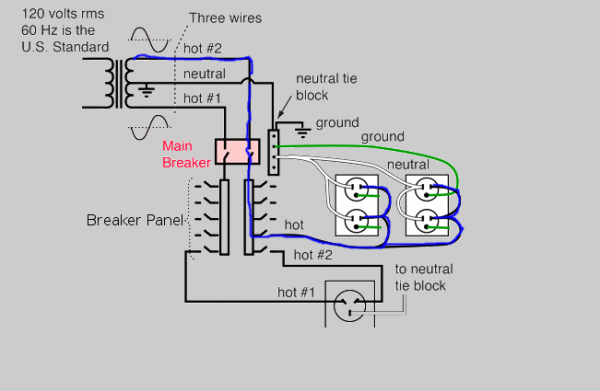
What a real breaker box looks like, as you can see the poles alternate. This is because the part in the middle that rises up connects to breaks on left and right at the center of the breaker box.
Stereophonic: The plug style doesn't matter, in your country the transformer simple puts out a different voltage. You still have L, N, and SG. But I don't know if you have 2 poles per residence from a single phase. I'm sure you're on single phase, but couldn't speak for whether you have 1 or 2 poles. It may be different from country to country, but 1 pole looks to be a common thing in some other countries besides US.

This is how AC systems actually look. Yes, as Speedskater says it is really only a single phase. However the phase gets split (center tap) so that you can have 120v instead of 240v. This gives you two effective poles that are "hot" (Line). These are the alternating spots for breakers that Ron mentioned.
Neither is positive and neither is negative on the poles. As you can see each pole has 360* of phase, and it flips between "negative & positive" every 180* there for there is "phase" because it is alternating (AC) up and down at 60 times a second (60hz). The neutral as you can see by itself cannot complete a circuit by connecting to SG (safety ground, the one connected to ground rod), because the path doesn't cross any of the transformer windings (SG & neutral are connected). But for both Hot poles (Lines), you can see that if they touch the other Hot, or SG it makes a complete circuit that includes the winding of the transformer. In this picture there is a primary and secondary winding, and the CT splits the secondary winding in two.
Here's an example of how Neutral cannot make a path through any windings of the transformer to complete a circuit that has power:

Here's how a normal connection is made for 120v that will complete a circuit through the transformer:

Here's how the two Hot poles can make 240v completing a circuit through the entire phase of the transformer:

Stereophonic: What your picture shows is just a way to determine which socket hole is Line (Hot). You put one test probe on SG and then see which L or N gives you 120v. The one that does give 120v is Hot, and true Line. If the small blade on the socket, or the L marking on an IEC cord does give you 120v, then you have the polarity swapped at some point (L and N were swapped).
audio.bill: Your link actually has nothing to do with polarity or phase at all of the electrical system, and only to do with polarity of the equipment. What it describes is finding which input wire of your transformer has the least amount of capacitance to the enclosure. Sadly there isn't much you can do about the problem without getting into the amplifier. Yes you can fiddle by swapping wires in the cord, but what you do is change where the fuse is applied, and that is a bad idea. Hopefully the designing should know better... The correct fix is to swap the transformer leads to corresponding switch & fuse, and neutral.
Ron Resnick: Again there is no positive. What your electrician is wanting to say, were he to understand it much better, is that you should only use 1 pole (1 Hot side of the transformer 120v) for the whole stereo. This is a decent idea for a few reason. Here's a drawing where you can see only one pole is used for the sockets. Please note that in a real breaker box the poles are mixed every other.

What a real breaker box looks like, as you can see the poles alternate. This is because the part in the middle that rises up connects to breaks on left and right at the center of the breaker box.
Stereophonic: The plug style doesn't matter, in your country the transformer simple puts out a different voltage. You still have L, N, and SG. But I don't know if you have 2 poles per residence from a single phase. I'm sure you're on single phase, but couldn't speak for whether you have 1 or 2 poles. It may be different from country to country, but 1 pole looks to be a common thing in some other countries besides US.
Here you can see how left and right breakers attach to the same pole, and alternate above and below. Each big bus bar that rises to connect to breakers in the middle is 1 pole, 120v worth of a 240v single phase. A 240v Breaker is a double stack that connects to both poles, and is used for things like your laundry dryer and oven. You can see one in the photo top left, where red and black are both Hot, Line 1 & Line 2. The white are the neutrals. (coily white is for a GFCI sensing breaker, which are for bathrooms)
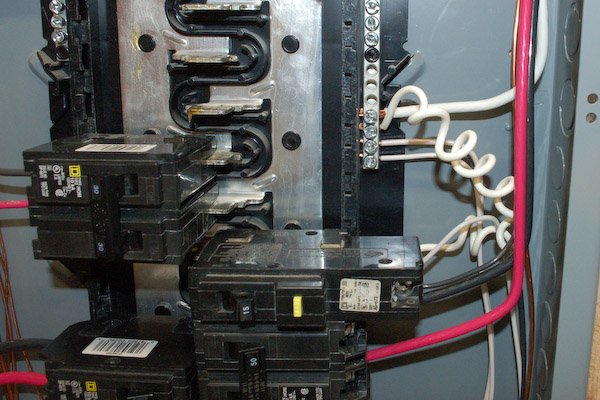

(...) Stereophonic: The plug style doesn't matter, in your country the transformer simple puts out a different voltage. You still have L, N, and SG. But I don't know if you have 2 poles per residence from a single phase. I'm sure you're on single phase, but couldn't speak for whether you have 1 or 2 poles. It may be different from country to country, but 1 pole looks to be a common thing in some other countries besides US.
There are several fundamental differences in mains distribution in Europe from the US practice. A grounded neutral wire is supplied by the mains company and we frequently have three separate phases (poles) 230V 50Hz in houses. Ground is local and separated from neutral - if you touch them it triggers the differential protection. Although we can have three phase sockets (5 wires, including ground) they are reserved to power appliances, such as cookers or three phase motors. In many countries in Europe (not the UK) sockets are not polarized, neutral and phase are not marked. Socket and plug insertion position is reversible, it is very simple to swap polarities. It is why I always test polarity for minimum current leakage to ground.
There are several fundamental differences in mains distribution in Europe from the US practice. A grounded neutral wire is supplied by the mains company and we frequently have three separate phases (poles) 230V 50Hz in houses. Ground is local and separated from neutral - if you touch them it triggers the differential protection. Although we can have three phase sockets (5 wires, including ground) they are reserved to power appliances, such as cookers or three phase motors. In many countries in Europe (not the UK) sockets are not polarized, neutral and phase are not marked. Socket and plug insertion position is reversible, it is very simple to swap polarities. It is why I always test polarity for minimum current leakage to ground.
Wow. I had no idea you sometimes had 3 phase... But it is different from place to place...
But I do have to wonder if you have 1 phase split into 3 poles? It is possible... True 3 phase is weird. This is what it looks like.
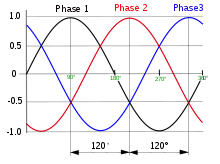
Similar threads
- Replies
- 2
- Views
- 719
- Replies
- 1
- Views
- 443
- Replies
- 3
- Views
- 787
- Replies
- 3
- Views
- 735
Members online
- JFRMusic
- Giotrude2
- Hiroshi
- Notdead
- Bonesy Jonesy
- Oortje
- rugyboogie
- ticktock
- joaovieira
- Steveo
- LarryK
- jmpsmash
- Gregadd
- andromedaaudio
- jazdoc
- Cappy
- the sound of Tao
- Estilovinilo
- ramesh
- Dimfer
- Massimo66
- SOS
- J007B
- RSB
- Norman Tracy
- Zarir
- kswanson27
- pevan
- respected_ent
- Mamon
- tubes59
- Rob77
- willgall
- Aries Cerat
- Stef
- amrs
- engadin
- Kris
- Davidny
- Glide3
- hi5harry
Total: 1,350 (members: 44, guests: 1,306)
| Steve Williams Site Founder | Site Owner | Administrator | Ron Resnick Site Co-Owner | Administrator | Julian (The Fixer) Website Build | Marketing Managersing |


